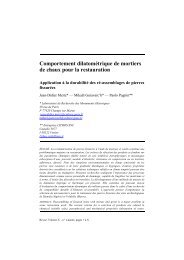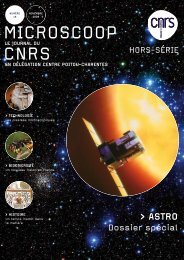Étude des propriétés hydriques et des mécanismes d ... - sacre
Étude des propriétés hydriques et des mécanismes d ... - sacre
Étude des propriétés hydriques et des mécanismes d ... - sacre
Create successful ePaper yourself
Turn your PDF publications into a flip-book with our unique Google optimized e-Paper software.
RESUME<br />
ETUDE DES PROPRIETES HYDRIQUES ET DES MECANISMES D’ALTERATION DE<br />
PIERRES CALCAIRES A FORTE POROSITE<br />
L’objectif principal de c<strong>et</strong>te thèse concerne l’étude, par une approche multi-échelles, du comportement <strong>des</strong><br />
pierres de monuments vis-à-vis de l’altération. A c<strong>et</strong> eff<strong>et</strong>, deux pierres de construction, dont certaines<br />
caractéristiques principales sont assez semblables (porosité totale, résistance mécanique), sont étudiées : le<br />
tuffeau blanc, qui est largement employé dans les constructions <strong>des</strong> châteaux du Val de Loire, <strong>et</strong> la pierre de<br />
Sébastopol, utilisée en région parisienne.<br />
Tout d’abord, une observation <strong>des</strong> différents types de dégradations rencontrées in-situ ainsi qu’une étude de<br />
cas sur une pierre altérée naturellement ont été réalisées afin de constater les différentes morphologies<br />
d’altération <strong>et</strong> d’identifier l’eau comme l’agent vecteur <strong>des</strong> phénomènes d’altération.<br />
Dans un second temps, une caractérisation multi-échelles a été effectuée afin de bien connaître les pierres<br />
non-altérées du point de vue de leur constitution minéralogique, de la morphologie de leur milieu poreux <strong>et</strong><br />
surtout de leurs <strong>propriétés</strong> <strong>hydriques</strong> (capacité de rétention d’eau, <strong>propriétés</strong> de transfert de l’eau sous forme<br />
liquide <strong>et</strong> sous forme vapeur) mais aussi de leur comportement hydro-mécanique.<br />
La dernière partie est consacrée à la durabilité <strong>des</strong> pierres mises en œuvre avec l’étude de la compatibilité<br />
entre les matériaux utilisées en restauration. En eff<strong>et</strong>, le comportement <strong>des</strong> pierres durant un essai de<br />
vieillissement artificiel est comparé. La réaction différente <strong>des</strong> deux pierres face à ce même processus<br />
d’altération est à relier directement à leurs <strong>propriétés</strong> <strong>hydriques</strong> très dissemblables. En dernier lieu, une<br />
formulation <strong>et</strong> une caractérisation hydro-mécanique de joints de mortier est proposée afin de déterminer les<br />
critères de compatibilité entre le mortier <strong>et</strong> les pierres en œuvre.<br />
Mots-clés :<br />
pierre, monument, calcaire, tuffeau, altération, milieu poreux, porosité, rétention d’eau, transfert hydrique,<br />
imbibition, capillarité, résistance mécanique, vieillissement par cyclage, mortier, chaux, compatibilité, durabilité.<br />
ABSTRACT<br />
STUDY OF WATER PROPERTIES AND MECHANISMS OF DETERIORATION FOR<br />
LIMESTONES WITH HIGH POROSITY<br />
The main objective of this work is the study, by a multi-scales approach, of the behaviour of building stones<br />
of monuments with respect to d<strong>et</strong>erioration. To this end, two building limestones, of which a few main<br />
characteristics are very close (total porosity, mechanical resistance), are studied: white tuffeau, which is<br />
largely employed in constructions of castles of the Loire Valley, and Sébastopol stone, used in Paris area.<br />
First of all, an observation of the various types of in-situ weathering and a case study on a naturally<br />
d<strong>et</strong>eriorated stone were carried out in order to note the various morphologies of d<strong>et</strong>erioration and to identify<br />
water like the agent vector of the phenomena of d<strong>et</strong>erioration.<br />
In the second time, a multi-scales characterization was carried out in order to observe the fresh stones from<br />
the point of view of their mineralogical constitution, the morphology of their porous media and especially of<br />
their water properties (water r<strong>et</strong>ention capacity, properties of transfer of water in liquid form and vapour<br />
form) but also of their hydro-mechanical behaviour.<br />
The last part is devoted to the durability of the building stones with the study of compatibility b<strong>et</strong>ween<br />
stones used in restoration. Indeed, behaviours of the stones during an artificial ageing test are compared.<br />
The different reaction of the two stones in relation with this same process of d<strong>et</strong>erioration is to be linked to<br />
their very dissimilar water properties. At last, a formulation and a hydro-mechanical characterization of<br />
joints of mortar are proposed in order to d<strong>et</strong>ermine the criteria of compatibility b<strong>et</strong>ween the mortar and the<br />
stones.<br />
Keywords:<br />
limestone, monument, tuffeau, weathering, porous media, porosity, water r<strong>et</strong>ention, water transfer, imbibition,<br />
capillarity, mechanical resistance, aging test with cycles, mortar, lime, compatibility, durability




